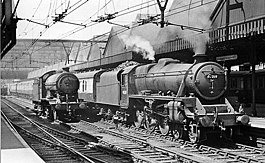Sheffield Victoria station
| Sheffield Victoria | |
|---|---|

Sheffield Victoria, as seen in 1957
|
|
| Location | |
| Place | Wicker, Sheffield |
| Area | City of Sheffield |
| Coordinates | 53°23′15″N 1°27′32″W / 53.387470°N 1.458760°WCoordinates: 53°23′15″N 1°27′32″W / 53.387470°N 1.458760°W |
| Grid reference | SK362880 |
| Operations | |
| Pre-grouping |
Manchester, Sheffield and Lincolnshire Railway Great Central Railway |
| Post-grouping |
London and North Eastern Railway London Midland Region of British Railways |
| Platforms | 5 |
| History | |
| 15 September 1851 | Opened |
| 5 January 1970 | Closed |
| Disused railway stations in the United Kingdom | |
| Closed railway stations in Britain A B C D–F G H–J K–L M–O P–R S T–V W–Z |
|
|
|
|
Sheffield Victoria was the main railway station in Sheffield, South Yorkshire, England, on the Great Central Railway, between Chesterfield and Penistone.
Engineered by Joseph Locke, the Sheffield, Ashton-under-Lyne and Manchester Railway linking Manchester and Sheffield opened in 1845. Originally, this line terminated at the Bridgehouses station about 0.7 miles (1 km) to the west of the future Victoria station. In 1847, the Sheffield, Ashton-under-Lyne and Manchester Railway merged with two other railway companies to form the Manchester, Sheffield and Lincolnshire Railway. The station at Bridgehouses had been outgrown and an extension and new station were planned. John Fowler, who later gained fame for co-designing the Forth Railway Bridge in Scotland, was employed to engineer the extension and station. Fowler's design included a viaduct over the Wicker that was 40 feet (12 m) high, 750 yards (690 m) long and two island platforms 1,000 ft (300 m) long. The extension was completed in 1847–1848 and the new Victoria station opened on 15 September 1851. The station gained a 400 ft (120 m)-long ridge furrow patterned glass roof likened at the time to The Crystal Palace (in London) which spanning the main line platforms in 1867 and was further enlarged in 1874, the well-known railway contractors Logan and Hemingway being awarded the contract.
With the opening of the London Extension in 1899, Sheffield gained a new direct service to London. To attract the lucrative trade between the cities, the Great Central Railway launched Sheffield Without A Stop on 1 July 1903 and became something of a trademark for the company, with 163.75 miles (263.53 km) being run in exactly 3 hours, an average of nearly 55 miles per hour (89 km/h). Slip coaches were provided for passengers for Leicester and Nottingham.
...
Wikipedia
